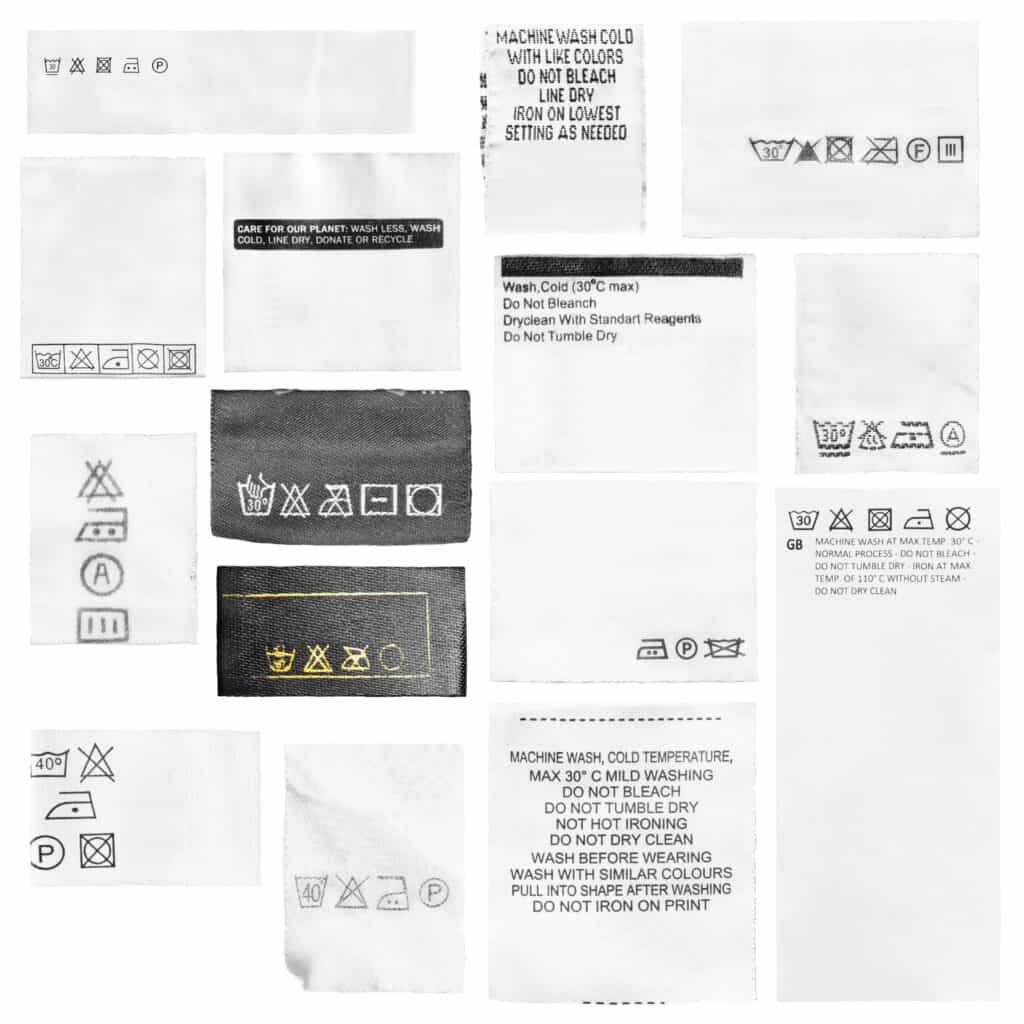Before washing your clothes, it is a good idea to sort them. Clothes are a necessity in life as they keep you looking and smelling nice if taken good care especially when washing.
However, most people do not have safer and more effective methods to wash clothes rather than just throwing them into the washing machine.
Therefore, sort your laundry by color, type of fabric, to what extent they are soiled, and per the specifications on the label. This will protect your clothes from damage and make your washing better and more efficient.
Step 1: Check each item.
Checking each item as you sort is a smart idea if your laundry is piled high.
This allows you to check for specific washing instructions on clothes and ensure that a red sock won’t wind up staining your lovely whites.

The first time you wash a piece of clothing, read the care instructions.
In case you overlooked the cleaning instructions or to determine whether you can group the item with other items, look at it once more when sorting.
To avoid mistakes, think about verifying each sorted item as you place it in the washing machine.
Step 2: Separate by color.
Sort your clothing first by color. To keep things in the appropriate pile, laundry organizing solutions like split hampers are helpful.
For whites, lights, and darks, you can specify separate baskets. At the very least, make a mound on the floor.
What makes whites and lights different from one another? Find out the quick steps for sorting the colors.
White Clothes
All of your stark white socks, shirts, jeans, and so on fall under this category. To keep your whites bright in these loads, you normally use bleach.
Most of all of these will be white. Two examples are a white work shirt with a collar or a white towel.
Light Clothes

Lights are hues and pastels that aren’t quite white but aren’t quite dark. These consist of your light pink blouse and your tan pants.
Do you want to know if gray laundry is light or dark? Dark grays go with dark clothing, whereas light grays go with light attire.
Dark or Colored Clothes
Dark and colorful attire makes a person stand out. These are the dark colors, such as black, deep gray, purple, navy, green, and occasionally red. Yellows, oranges, and reds are among the bright colors you should add to this pile.
This extends to garments with multiple colors and even tie-dye. An illustration would be a pair of flannel pants, primarily red and blue, with a touch of white.
Even if they contain a small amount of white, they belong in the pile of dark and colored objects.
Step 3: Sort by fabric weight.
You probably own products with various fabrics and textures. After grouping the items into color piles, sorting them out can assure a variety of things, including the quality of your delicates and the avoidance of lint sticking to particular textiles. It may also speed up and level out the drying process.
Sort any delicates into color-coded piles. Lingerie, pantyhose, washable silks, and other goods you want to protect from the severe agitation of the washing machine are considered delicates.
Separate “lint-givers” and “lint-receivers” in your inventory. For instance, you shouldn’t mix towels with corduroy clothing.
If you wish to run a different washing cycle, think about separating synthetics and natural fibers. This may help to stop lint further.
Sort your wardrobe into lighter and heavier weight categories. For instance, you shouldn’t wear thin t-shirts with thick cotton slacks. When washed, the heavier fabric may scratch lighter, more delicate items.
Step 4: Assign very soiled clothes to another pile.
Consider placing heavily discolored or filthy items in a different pile if you have any.
These goods could need to have stains pretreated or washed on a specialized cycle that is too abrasive for normal clothing.
Additionally, it stops soils or stains from reappearing on cleaner items.
Before placing it in the washer, address any stains or odors using a stain remover. This can stop stains from spreading or being redeposited.
Step 5: Create subcategories.
If you’re dedicated to washing your clothes and other items as efficiently as possible, you might think about setting up subcategories as different cycles.
Towels and bedding, for instance, are frequently heavier than clothing, while newborn or infant outfits are made of light hues.
These subcategories can help further shield your clothing and other belongings from harm.
What to consider before sorting laundry

The simplest part of cleaning clothes is sorting.
Wrong.
The most challenging and time-consuming aspect of laundry is sorting. Sorting can damage machines and spoil garments if done incorrectly. Sorting properly can save you significant time, effort, and money.
When sorting laundry, there are six key things to keep an eye out for. Only one of them is actually sorting the clothing into the appropriate pile.
Check clothing tags.

To find out how to wash, dry, and iron the clothing, carefully read the label. The majority of goods will only have standard washing instructions.
The fact that you have items that should be hand-washed or not dried in a dryer may surprise you. Be mindful of the fabric kind. Put these things in a separate “Special Care” pile.
Turn clothing right side out.
Make sure that none of your shirt or pants’ arms are inappropriately tucked into the clothing.
Take the time right away to secure the overalls’ latches to their correct buttons if you’re washing them to prevent them from being broken, strained, or torn.
Make sure to wash the clothing inside out if it was recommended on any garment tags.
Check all pockets.
It is ideal for keeping a bowl close by to collect the items from your pockets. Lipstick, mobile phones, sensitive documents, or even cash all be unpleasant surprises in unchecked pockets.
Check for sewing repairs.
Ensure that there are no tears, loose threads, button fixes, or other sewing-related defects. Repair any you find before washing the garments. The difficulties will only get worse if you wash them in them.
Check for stains.
Before washing and drying, they will need to be treated beforehand or soaked. A stain that dries will probably stay on your clothing forever.
Why should you sort laundry before washing
Sort for Effective Stain Removal
Stain cleaning is one component of sorting that must be taken into account. It’s one thing for garments that aren’t too dirty, but if tough or numerous stains aren’t removed before washing, the clothes might not be able to be cleaned.
Therefore, please take out the garments that have substantial grass, food, or blood stains first, soak them, or dab laundry detergent directly on the stain before washing.
Additionally, be sure to pretreat the stains according to the type of stain. For instance, many stains can be pretreated by soaking the clothing in a solution of warm water and vinegar for about an hour while occasionally agitating the garments.
It’s crucial to use cold water rather than warm water to remove blood stains. Blood stains may become permanently fixed into the cloth as a result of heat.
Sort to Preserve Color
You want to maintain the color and brightness of your colored fabrics at the same level as when you first purchased them. That has always meant sorting laundry into three groups based on color: whites, lights, and darks.
Separating light and dark-colored laundry is less necessary when using modern washers, dryers, and laundry supplies.
Although keeping lights and darks separate is no longer technically necessary, you may still wish to separate newly purchased dark-colored items from the rest in case there are excess dyes that could bleed during the first wash.
If you intend to use bleaches or bluing agents to keep your whites brilliant, it is still crucial to separate whites and colors. On colored garments, fading or spots can be caused by products designed for white linens and apparel.
Less wear and tear
Friction from heavier materials, buttons, and zippers can cause damage. The life of more fragile goods will be prolonged if they are stored among similar items or with older towels—Wash similar clothes with matching fabrics.
Reduce Lint Build Up
Bath towels can cause an ugly lint buildup on your clothing if you throw them in with jeans, dark slacks, cotton shirts, or other items. After that, you’ll spend hours cleaning your beloved jeans or lint balls. There is no time for that.
When sorting your laundry, there are additional considerations as well. For the cleanest load possible, be sure to take each into account.
Sort to Protect Delicate Fabrics
Organize your garments by fabric composition to finish. When categorizing by materials, there are generally four categories to take into account: delicates, denim, towels, and everything else.
Among the delicate materials are silk, satin, lace, and netting. These garments must be hand-washed or put through a gentle cycle.
When wet, denim is very heavy and takes a long time to dry. Denim objects may not be cleaned and dried correctly if not washed by themselves.
Although it’s typically okay to wash towels alongside things like bed linens, they will leave lint all over your clothes and other items if they’re not separated.
Unless the label says otherwise, the rest of your garments, including cotton blends, T-shirts, and other clothing, can typically be washed together.
Is laundry sorting sustainable?
You don’t need to be an expert in mathematics to understand that larger collections of sorted clothing result in larger loads and more washing cycles, which in turn use more water, electricity, and resources overall.
Although sustainability is something we should always take into account in our daily lives, if you have a more modern, high-tech washing machine, things might not be as bad as you think. Especially when you take into account the prolonged use you will get out of your clothes when they are washed properly.
Next, you can check out my complete guide on how to fold clothes fast, or my list of the best laundry hampers for college.

I’m an expert wardrobe organizer and a bit of a clean freak. I created this website and its YouTube channel to share practical guides about laundry and organizing. My teachings have been featured in multiple large news publications, and I’ve self-published two wardrobe organizing books and an entire course on the subject.

